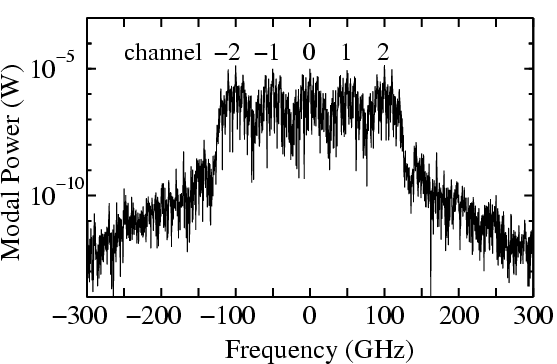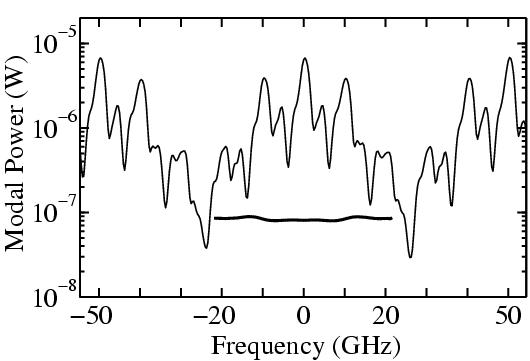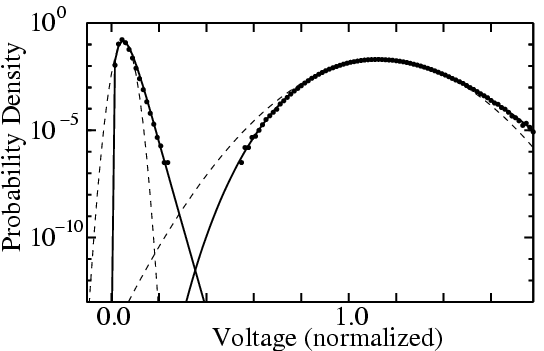A Covariance Matrix Method for
Calculating Accurate Bit Error Rates in a DWDM chirped RZ
SystemR. Holzlohner, C. Menyuk, V. Grigoryan, Univ. of
Maryland Baltimore County, Baltimore, MD; W. Kath,
Northwestern University, Chicago, IL.
1
IntroductionAmplifier spontaneous emission (ASE) noise
sets the lower limit on the allowed system power in current
optical fiber communication system [1]. At the receiver, ASE
noise leads to amplitude and timing jitter and deteriorates
the bit error rate (BER). The ASE noise spectrum is white over
the spectral width of one channel. However, due to the
nonlinearity of the optical fibers leading to cross-phase
modulation and four-wave mixing, the noise interacts with the
signal in a complex way that usually increases the signal
degradation. The traditional computation of the probability
density function (pdf) of the electrical signal in the
receiver, based on Monte-Carlo simulations, only works for a
limited range of BERs, beyond which the BER has to be
extrapolated [2]. Extrapolation methods to date assume that
the receiver voltage is Gaussian distributed. This assumption
is not always reliable. Moreover, the Monte Carlo methods are
computationally expensive. Thus, they are usually replaced in
practice by approximations-the most common of which is to
simply neglect noise altogether during propagation and add
Gaussian white noise at the entry to the receiver. This and
similar approaches are usually not well-validated.
In this
contribution, we numerically study a 10Gb/s 5-channel chirped
return to zero (CRZ) system with a 50GHz channel spacing,
transmitting data over 6,100km. This system resembles a DWDM
submarine system [3]. We reduced the number of channels to
five in keeping with earlier results indicating that it
suffices to simulate a limited number of channels [4]. The
covariance matrix method relies on the assumption that the
interaction of the optical noise in the fiber with itself is
negligible. Noise-noise interactions must be kept in the
receiver model. We calculate the linearized evolution of the
noise around the noise-free signal without the use of Monte
Carlo simulations. The optical noise at the entry to the
receiver is multivariate Gaussian distributed after the phase
jitter is removed from the noise and is completely described
by a covariance matrix [5]. We have previously applied this
method to a highly nonlinear dispersion-managed soliton system
(DMS) over 24,000km [5], [6] and to a single-channel CRZ
system [7], [8] with the same parameters as the central
channel in the 5-channel system that we study in this work.
The validity of our approach was proven in these references
for a wide range of single-channel systems. Hence the focus of
this paper is on extending the covariance matrix method to
multiple channels.
2 Theory and ResultsOur
simulated transmission line is identical to [7], [8] and
consists of 34 dispersion maps each of length 180km for a
total distance of 6,120km. Every 45km, the loss is compensated
by an EDFA with a spontaneous emission factor of
nsp=2.0. We transmit the same pseudorandom
bit sequence of 2
5=32 bits in all channels,
exhausting all possible bit patterns of length 5. Fig. 1 shows
the noise-free optical power spectrum at the receiver.
 Fig.
1.
Fig.
1. Noise-free optical power spectrum at the end of the
transmission line. The channel spacing is 50GHz, and the
channels are indicated by numbers. The noise analysis is
carried out for channel 0.
We compute the covariance matrix
as described in [7] by perturbing the noise-free signal by a
small amount in each frequency separately. We separate the
phase jitter from the covariance matrix at each amplifier.
When dealing with strings that contain many overlapping bits,
one needs to consider that each pulse in the signal of each
channel has a different phase. In a system in which pulses do
not overlap, such as a soliton system, the phase jitter can be
easily separated from each pulse individually. However, in the
present system the maximum FWHM pulse duration is about 210ps,
leading to a significant pulse overlap [7]. The phase jitter
is separated in the simulation after applying artificial
dispersion compensation. This procedure compresses the pulses,
and we then separate the phase jitter individually for each
pulse. Finally, the opposite dispersion is used to restore the
signal shape. We find that timing jitter is small and does not
have to be separated from the rest of the noise. In other
words, we employ the same algorithm as for the single-channel
CRZ system [7], but before we perform the phase jitter
separation at each amplifier, we filter out the four
surrounding channels since they would otherwise distort the
pulse phase of the central channel. As previously, the
frequency range of the noise in the covariance matrix is
±22GHz, equaling about half the channel spacing in either
direction, which is the relevant range after demultiplexing
the central channel. By only keeping the covariance matrix for
the central channel, we neglect the linear coupling of the
noise modes in the central channel with the noise modes in the
other channels. However, we do take into account the
interaction of the noise modes in the central channel with the
noise-free signal in all channels, because the evolution of
the perturbation in each frequency is computed in the presence
of all five channels. Using the covariance matrix, we compute
the pdf of the electrical voltage. At the receiver, we assume
that there is an ideal square law detector followed by a 5-th
order Bessel filter with a bandwidth of 8.6GHz.
Fig. 2
shows the smoothed power spectrum of the noise-free signal in
the upper curve and the matrix principal diagonal that
represents the power spectrum of the noise, in the lower thick
curve. The OSNR in channel 0 is 11.2dB, where we define the
OSNR as the total signal power divided by the total noise
power each computed in the frequency range of ±22 GHz. The
noise spectrum is a minimum at zero frequency and has peaks at
±13 GHz that are due to parametric gain; the ratio of the
spectral power at the noise peaks to that in the minimum is
1.12. The optical noise entering the receiver is often assumed
to be white, corresponding to a covariance matrix with a
constant diagonal and zeros elsewhere. This crude
approximation can lead to inaccurate BERs, because in reality
the diagonal matrix elements vary, and the off-diagonal
elements are nonzero.
 Fig.
2.
Fig.
2. Upper thin curve: same spectrum as in Fig. 1, but
smoothed, lower thick curve: noise power spectrum at the
receiver in channel 0.
We validate our results by comparing
the pdfs from the covariance matrix method to extensive Monte
Carlo simulations. In Fig. 3, the dots represent a histogram
of the receiver voltage from 100,000 Monte Carlo noise
realizations. The voltage is normalized to the noise-free peak
voltage. The dashed curves show a Gaussian fit to the dots,
based on their mean and variance. The solid curves show the
accurate pdfs from our method. All pdfs are averaged over the
16 marks and the 16 spaces in the 32-bit signal. The agreement
between the covariance matrix method and the Monte Carlo
results is excellent. By integrating the pdfs we obtain an
optimal BER of 4.7×10
−12 from the covariance matrix
method and 4.1×10
−11 from the Gaussian fit of the
Monte Carlo data. These values are within a factor of 3 of
what we found in a single-channel simulation [7]. The Gaussian
BER corresponds to a
Q-factor of 6.50. Note that the
reason that the Gaussian BER does not differ very strongly
from the accurate result in this case is that it overestimates
the pdf of the marks and underestimates it in the spaces, and
hence the
Q-factor method relies on the accidental
partial cancellation of two errors. We also computed the
covariance matrix and the pdf for channel 1, which yields very
similar results.
 Fig.
3.
Fig.
3. Histogram of a traditional Monte Carlo simulation
(dots) with Gaussian fits of the data points in the marks and
spaces based on their mean and variance (dashed lines) and the
pdf of the covariance matrix method (solid line).
3
ConclusionsWe extended the covariance matrix method to
a 10Gb/s chirped RZ system with a transmission distance of
6,100km with 5 channels, spaced 50GHz apart. We were able to
compute the accurate pdfs and the BER in a given channel of a
signal with 32 strongly overlapping bits. The simulation time
increase, compared to a single-channel system, depends
exclusively on the step size reduction of the split-step
algorithm due to the additional channels. The computational
cost of our method equals that of a Monte Carlo simulation
with twice as many noise realizations as the number of complex
Fourier modes in the covariance matrix; in this work we used
140 modes. Therefore we propose that traditional Monte Carlo
simulations be abandoned in favor of the covariance matrix
method, both for calculating accurate BERs and for checking
the validity of simplified approaches like using Gaussian
white noise at the entry to the
receiver.
References[1] J. P. Gordon and H. A.
Haus, "Random walk of coherently amplified solitons in optical
fiber transmission," Opt. Lett.
11, 665-667
(1986).
[2] N. S. Bergano, F. W. Kerfoot, and C. R.
Davidson, "Margin measurements in optical amplifier systems,"
IEEE Photon. Technol. Lett.
5, 304-306 (1993).
[3]
M. Vaa
et al., "Demonstration of a 640Gbit/s×7000 km
submarine transmission system technology ready for field
deployment," In
Proc. OFC'01, paper WF5 (Anaheim, CA,
2001).
[4] T. Yu, W. Reimer, V. S. Grigoryan, and C. R.
Menyuk, "A mean field approach for simulating
wavelength-division multiplexed systems," IEEE Photon.
Technol. Lett.
12, 443-445 (2000).
[5] R.
Holzlöhner, V. S. Grigoryan, C. R. Menyuk, and W. L. Kath,
"Accurate calculation of eye diagrams and bit error rates in
long-haul transmission systems using linearization," J.
Lightwave Technol.
20, 389-400 (2002).
[6] R.
Holzlöhner, C. R. Menyuk, V. S. Grigoryan, and W. L. Kath,
"Direct calculation of the noise evolution in a highly
nonlinear transmission system using the covariance matrix," In
Proc. CLEO'02, talk CThG5 (Long Beach, CA,
2002).
[7] R. Holzlöhner, C. R. Menyuk, W. L. Kath, and V.
S. Grigoryan, "Efficient and accurate calculation of eye
diagrams and bit-error rates in a single-channel CRZ system,"
IEEE Photon. Technol. Lett.
14, 1079-1081
(2002).
[8] R. Holzlöhner, C. R. Menyuk, V. S. Grigoryan,
and W. L. Kath, "Efficient and accurate computation of eye
diagrams and bit error rates in a single-channel CRZ system,"
In
Proc. CLEO'02, poster CThO44 (Long Beach, CA,
2002)
Abstract:We present a covariance
matrix method to compute accurate error rates in a 10Gb/s DWDM
chirped RZ transmission system with channels spaced 50GHz
apart at the computational cost of only 280 Monte Carlo noise
realizations.








